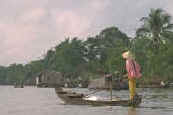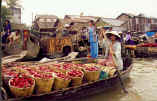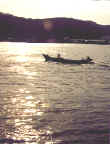The far south of Vietnam is one of the two main ricebowls of the country. Dominated by the Mekong Delta, the surrounding lands are comprised of low lying rice paddies and the rivers are bordered by dense mangroves and palms. The tributaries of the hectic Mekong River highway provide a comprehensive network of canals and channels. The rivers are the best methods to explore the region at a leisurely pace and offer the opportunity to experience the truly unique Mekong River lifestyle.
Mytho |
|
Mytho
Mytho is a delightful town, situated about two hours by bus south west of Ho Chi Minh city. Sitting on the bank of The Mekong River, Mytho is divided into two by a tributary of the river. From here you can do a number of short boat trips to various islands and floating markets within the surrounding are. It is also a good place to catch the overnight long boats to a variety of locations including Chau Doc and Long Xuyen. A quiet evening in Mytho can be spent on your veranda watching the sun set and the fishing fleet unload after dark. During the day you ca spend hours in a nearby cafe simply watching life go by, or on the river, cruising the day away. The Mytho experience is enhanced by the fact that the streets are generally extremely quiet. Mytho is mot a place where you need to worry about being decapitated by a bike carrying six people and half a ton of corrugatediron speeding along at 100 kph.
Along 30 thang 4 street is an amazing demonstration of the bizarre Vietnamese taste for really tacky photos. Rather than have their photo taken with the background of the flowing Mekong River, photographers have erected all manner of cardboard backings with snow scenes, stuffed deer and to add that final tough of authenticity, their assistants are dressed as pandas. Just a bit down from the strange signs there is a quiet little park where you can savour a baguette and watch the sun set.
Con Phung island
This island is also known as the Island of the Coconut Monk named after a monk, Ong Dao Dua, who meditated on the island for three years during which he ate nothing but coconuts. An active supporter of the reunification of Vietnam, he strongly believed that reunification could be achieved by peaceful means. In the early 1960s he founded a community in support of this ideal, and as a result was imprisoned by President Diem on a number occasions. At his time, the island became a sanctuary for those who were attempting to escape the ravages of war. Ong Dao Dua also headed his own sect, which was a bizarre mix of Christianity and Buddhism. The large cross that you may stumble upon in his sanctuary is not a swastika, but actually communist victory his community dissolved, and the island is now a little run down. You can reach Con Phung island by boat from Mytho which takes about half an hour.
Snake farm
If you enjoy having enormous pythons wrapped around you, this is the place for you as snakes are greed here for anti-venom and medicinal purposes. If snakes do not turn you on, then bay be the turtles will. The Snake Farm is home to two yellow turtles, the only two living of their species known to the human race. They live to 1,000 years old so these ones have another 800 years to look forward to. The Thai government offered USD 250,000 for the turtles, but the Vietnamese authorities declined the ‘generous’ offer, so that they could keep these very special creatures.
Ben Tre
Ben Tre is made up of seven districts with Chau Thanh being the main city, surrounded by many islands that are covered in coconut trees. Ben Tre is known throughout Vietnam for its masses of coconut palms, and during the war the coconut oil was used as a valuable substitute for kerosene. This are is relatively untouched by tourism, and this is evident in the fact that NOBODY speaks English in Ben Tre. Even the tourist office has trouble communicating. Communication problems aside, you will find the people of Ben Tre to be exceedingly friendly and the countryside is beautiful. There is also a daily fresh produce market that is extremely colourful and worth visiting. Due to the limited exposure to tourism, Ben Tre can leave you with a purely cultural experience.
Vinh Long
 The town of Vinh Long is set on the edge of its principal
attraction, the Mekong River. More precisely it is the beautiful islands that you can
visit from here that may attract you to use Vinh Long as a base. Vinh Long is
uncharacteristically large for the Mekong Delta, displaying an abundance of tall buildings
and Karaoke bars to tempt your vocal chords. At one stage in Vietnam’s history, Vinh
Long was at the centre of a Christian stronghold. Although Christians no longer dominate
in the area, there is still a cathedral that is worth looking at.
The town of Vinh Long is set on the edge of its principal
attraction, the Mekong River. More precisely it is the beautiful islands that you can
visit from here that may attract you to use Vinh Long as a base. Vinh Long is
uncharacteristically large for the Mekong Delta, displaying an abundance of tall buildings
and Karaoke bars to tempt your vocal chords. At one stage in Vietnam’s history, Vinh
Long was at the centre of a Christian stronghold. Although Christians no longer dominate
in the area, there is still a cathedral that is worth looking at.
Most people that visit Vinh Long use it as a base to explore the islands which are home to people that grow exotic produce. One of the more popular islands to visit has several rambutan and banzai tree gardens with many different fruits and flowers that you can visit.
Can Tho
Can Tho is a thriving metropolis with huge streets, little action and loads of mosquitoes. Although Can Tho has its own market by the riverside, where you can get excellent ice-cream, the principal attraction would have to be the nearby floating markets. Being rather industrious, the centre of Can Tho is quite busy and noisy with motorised cyclos roaring up and down the streets combined with throngs of people going about their lives. The riverside can have its quiet moments, but Can Tho is also a burgeoning are a number of pagodas worth visiting, and for the trivia fans, Can Tho is the home to much of Vietnam’s fish sauce.
Markets
 Cai Rang Market is situated about 8 km from Can Tho by road or a 20 km loop
by boat. This market is quite nice and sells a variety of fruit and vegetables and
operates from 5 am to 11 am, though the markets are better the earlier you can get there.
A cyclo from Can Tho will take about 15 minutes to get to Cai Rang Market. Another market,
Phung Hiep market, is 31 km from Can Tho. This is the snake market, selling a plethora of
living, wriggling and often poisonous snakes. Pythons and Cobras are sold here by people
from the countryside who have caught them by hand, whilst others have come to purchase
snakes for restaurants, medicinal reasons or personal consumption. This market is open
from 5 am to 5 pm. If travelling by boat, you can add a dimension to your day by stopping
and visiting some of the fruit gardens, which sell pineapple, rambutan and papaya amongst
many other fruits.
Cai Rang Market is situated about 8 km from Can Tho by road or a 20 km loop
by boat. This market is quite nice and sells a variety of fruit and vegetables and
operates from 5 am to 11 am, though the markets are better the earlier you can get there.
A cyclo from Can Tho will take about 15 minutes to get to Cai Rang Market. Another market,
Phung Hiep market, is 31 km from Can Tho. This is the snake market, selling a plethora of
living, wriggling and often poisonous snakes. Pythons and Cobras are sold here by people
from the countryside who have caught them by hand, whilst others have come to purchase
snakes for restaurants, medicinal reasons or personal consumption. This market is open
from 5 am to 5 pm. If travelling by boat, you can add a dimension to your day by stopping
and visiting some of the fruit gardens, which sell pineapple, rambutan and papaya amongst
many other fruits.
Soc Trang
Soc Trang is situated on Highway 1 and makes for a perfect place to break the journey from My Tho to Ca Mau. With a 500 kg Vampire pig and a psychedelic pagoda to see, Soc Trang is well worth a visit to experience a bit of the bizarre side of life in Vietnam.
Soc Trang is the home to two fascinating pagodas. The first one is the Khmer Bat Pagoda. The grounds are spacious and serene and the pagoda is lovely. About 20,000 fruit bats with dog-like faces live on the grounds of the pagoda, and an individual bat can weigh up to half a kilo. What gives the pagoda a twilight zone appeal is the fact that the bats only live on the trees within the pagoda grounds, and they eat no fruit from within the pagoda. For surreal appeal there is also a five year old 500 kg Vampire Pig in residence. This Pig has five ‘toe things’ instead of the usual four and to top it off, the Pig has fangs which are really weird.
The second is Dat Set (Soil) Pagoda. This is a truly incredible pagoda boasting hundreds of statues made of soil. Even the building and pillars were once made of soil, but have since been replaced with more stable concrete. There is a huge dragon and a huge tiger statue that protect the gold mountain, whilst a lion protects the silver mountain. However the most intriguing part of the pagoda is the candles. There are four large candles, two of which have never been lit and stand at 2.6 m high, weighing 200 kg. The other two candles have been burning continuously for the last twenty years and are only half done. There are crazy multicoloured flickering lights everywhere giving the pagoda a psychedelic Christmas feeling.
Ca Mau
Ca Mau is situated in one of the largest swamplands in the world, surpassed only by the Amazon basin. This provides Ca Mau with its unique attraction of the U-Minh mangrove forest.
U-Minh Forest
U-Minh is the largest mangrove swamp that can be found excepting the Amazon. Once in U-Minh forest you can take an interesting walk around the rice fields and mangrove forests. It is very quiet and spacious, making a worthwhile day trip from Ca Mau.
Bird Parks
There are two bird parks that you can visit from ca Mau. The first, Bac Lieu bird garden can be found about 3 km out of Bac Lieu. The second bird garden is in Minh Hai in Vuon Chim in the Bam Doi District.
Rach Gia
This laid back fishing town is the capital of the Kien Giang province and faces the Gulf of Thailand. The main part of town is on an island connected by four roads that cross the channel. Some of the tastiest and cheapest local food is sold on the northern end of Hung Vuong Street. Rach Gia is considered a stronghold of the Cao Dai faith.
It is almost worth getting up at 5 or 6 am to watch the boats come in from a night of fishing. The fishing docks on the sea side of the island are a hive of activity while all the fish are being sorted.
Phu Quoc island Situated in the Gulf of Thailand, close to both Ha Tien, Rack Gia and the Cambodian coast, Phu Quoc Island possesses excellent white sand beaches and great snorkelling opportunities. Some of the islands to the South of Phu Quoc are also great for swimming and viewing the marine life.
Hon Chong Hon Chong is a sleepy seaside village where a few days could be spent laying in a hammock, exploring the surrounding islands and caves or both. It makes for a nice break from the bedlam of the larger town of the Delta, and you can escape from the heat by taking a swim at some of the nicest beaches in Vietnam. The population of Hon Chong is about fifty percent Khmer owing to its proximity to Cambodia.
Ha Tien
 Ha Tien, a very beautiful beach and market town,
is situated virtually on the Vietnamese-Cambodian border and offers a diverse spread of
Vietnamese life. There is a high percentage of Khmers living in this area, reflecting the
historical significance of the area that has changed hands between Cambodia and Vietnam
and in the late 1970s bore the brunt of Khmer Rouge raids across the frontier. Today ha
Tien is a bustling smuggling town between two former enemies, but for the traveller, the
main attractions of the area are the superb beaches.
Ha Tien, a very beautiful beach and market town,
is situated virtually on the Vietnamese-Cambodian border and offers a diverse spread of
Vietnamese life. There is a high percentage of Khmers living in this area, reflecting the
historical significance of the area that has changed hands between Cambodia and Vietnam
and in the late 1970s bore the brunt of Khmer Rouge raids across the frontier. Today ha
Tien is a bustling smuggling town between two former enemies, but for the traveller, the
main attractions of the area are the superb beaches.
Chau Doc Chau Doc sits on a tributary of the Bassic River and is an incredibly friendly bustling little city. The people here are known for being very warm and approachable. Chau Doc is also right on the Cambodian Border and if you were able to enter Cambodia by boat, you would pass through here.
Sam Mountain
The main attraction of Chau Doc is Sam Mountain. Situated 7 km from town along Bao Ho Thoai Street, the mountain has a number of pagodas at its base, and some kind of army listening post on the top. The main pagoda gets full marks for kitsch. Although the pagodas at the base of the mountain are nothing to write home about, the view from the top of the mountain is well worth the climb.
Markets
Chau Doc has a large covered street market on Le Cong Thanh Street. Here you can get everything from something tasty to eat to a new Hi Fi. There is also a great food market by the river, past the post office.
Ba Chuc
Ba Chuc is situated between Chau Doc and Long Xuyen where there is a temple and ossuary dedicated to over 3,000 Vietnamese that the Khmer Rouge massacred in September 1978. It is very moving and well worth visiting.